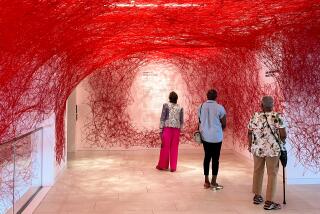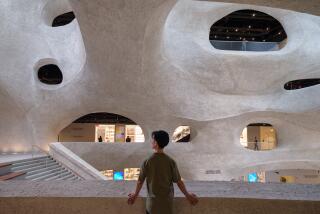Turning to science as a safeguard
RESEARCH on feather art and conservation has a long way to go, but a joint project of the Getty Conservation Institute and UCLA’s Cotsen Institute of Archaeology is making inroads in one important area: how and why feathers fade. The goal is to learn more about feathers and establish general guidelines for their safe display.
Lionel Keene, an assistant scientist at the Getty, and Ellen Pearlstein, a conservation expert at UCLA, are using the Getty’s microfadometer -- a device that trains an intense beam of light on a pinpoint spot -- to test rates of fading on a wide range of feathers. Built according to specifications of scientist Paul Whitmore, the machine allows accelerated fading tests to be conducted on real objects without noticeable damage. The Getty and a few other art institutions have tested fading of various materials, but the study of feathers is new.
“Any time you get in on the ground level, it makes for exciting research,” says Keene, observing a computer screen that’s tracking the process of an experiment.
Pearlstein caught the feather bug when she became a consulting conservator for an upcoming exhibition of Mexican featherwork. “My concern,” she says, “was how can you responsibly ask museums to lend objects when they are physically very fragile and there are legal issues about exporting them across international borders and concerns about lighting. Then I realized the problems with the literature. I found three articles written for the conservation community that talked at all about feathers. There still are just those three. I began to get very interested.”
To get started, she and Keene borrowed taxidermic birds from the Natural History Museum of Los Angeles County and, for comparison, looked for fresh examples of the same feathers. “We wanted to have something recently removed from the bird, as well as an artifact,” Pearlstein says.
Art and ethnographic museums aren’t eager to lend valuable objects to experiments, no matter how safe. In what Pearlstein calls “a coup,” she located a Maidu Indian-style headdress made from the shafts of red flicker feathers in 1992, in the collection of the Point Reyes National Seashore Science Museum. Because it was made by an anthropologist, not a Maidu, the museum cheerfully lent it. What’s more, the museum had kept careful records of the headdress’ exposure to light when in storage and on display. Then came flicker feathers collected from a bird in the Santa Monica Mountains.
Time to get to work.
-- Suzanne Muchnic
More to Read
The biggest entertainment stories
Get our big stories about Hollywood, film, television, music, arts, culture and more right in your inbox as soon as they publish.
You may occasionally receive promotional content from the Los Angeles Times.










